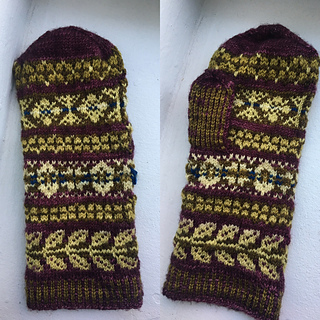patterns >  the river knitter®
the river knitter®
> Shetland Garden Mittens





















Shetland Garden Mittens
Please note that, effective June 25, 2019, this pattern is now free. I have made this change because I will no longer be able to provide pattern support. No refunds for previous purchases will be made. Thank you.
These stranded colorwork mittens were designed with fifteen beautiful and subtle shades of Shetland fingering weight yarn for an overall muted effect, however the pattern is written so the knitter may choose among three different versions - the original 15-color version, as well as 6-color and 3-color alternatives.
Designed with a long cuff and an afterthought (peasant) thumb, these mittens feature four different charted colorwork patterns.
The pattern includes written instructions and charts for three adult sizes. It may be helpful to use a highlighter to mark the sections of the written instructions for your size and color version choice.
Yarn
Jamieson’s Shetland Spindrift (100% Shetland wool, 105m/115yd per 25g ball) in 15 (6, 3) different shades. Spindrift is a fingering weight 2-ply yarn that knits up like a traditional 4-ply jumperweight Shetland.
A total of approximately 390 yards of yarn is required to knit the largest size, with varying amounts of background colors (MC) and pattern colors (CC), depending on the version chosen. The 15-color and 6-color versions require only very small amounts of many of the contrast colors.
If you do not wish to invest in full balls of colors for which you’ll only need a small amount, 20-yard mini-skeins of Spindrift are available from Feral Knitter, who also sells all the available shades. Another excellent source in the U.S. for all the shades of Spindrift is Schoolhouse Press.
Although the suggested yarn is Jamieson’s Shetland Spindrift, any suitable fingering weight yarn may be substituted, or a heavier weight yarn may be used to size the mittens up in both length and circumference.
Needles:
These mittens were originally knit on one long circular needle, using the magic loop method. Two circular needles or double-pointed needles (dpns) may also be used.
Gauge:
The difference in the amount of yarn used for the three sizes is very small, and the amounts stated allow for working a gauge swatch. I strongly urge you to take the time to work a gauge swatch to ensure a good fit. Because gauge can be affected by stranding, it’s important that the swatch be knit in a colorwork pattern.
Sizes:
The pattern includes 3 adult sizes. The overall design is the same for all sizes, but there are very slight variations in the charts in order to accommodate the different number of stitches. Each size has its own set of charts which may be printed out separately from the main written pattern.
Small size:
Length: 9.5” (including a 3” cuff)
Hand circumference: 7.5”
Medium size:
Length: 10.25” (including a 3.25” cuff)
Hand circumference: 8”
Large size:
Length: 11” (including a 3.5” cuff)
Hand circumference: 8.75”
Pattern note for the Large size: to maintain the symmetry of the checkered pattern, 2 increases are worked on a plain round before working the chart and then 2 decreases are worked on a plain round after working the chart. The points where these increases and decreases are worked are clearly indicated in the written instructions.
Skills and Techniques Required:
- German Twisted or other preferred long tail cast on
- Corrugated ribbing
- Stranded colorwork knitting
- Knitting in the round
- Increases (m1L or m1R - described in pattern)
- Decreases (ssk, k2tog - described in pattern)
- Setting up for an afterthought/peasant thumb
- Picking up stitches for an afterthought thumb
- Grafting stitches (Kitchener stitch)
Resources:
If you need extra guidance in working the afterthought, or ‘peasant’ thumb, there are many resources available online, such as Mary Jane Mucklestone’s tutorial or the excellent step-by-step guidance in the book, Spilly Jane Mittens.
For an explanation of color dominance (how to hold the MC and the CC in stranded colorwork so that the pattern stands out against the background) see Ysolda Teague’s tutorial or this one from Twist Collective. Both are detailed and very clear.
For step-by-step instructions for making your own set of durable and inexpensive mitten blockers see this tutorial.
Many thanks to the test knitters and friends, finnsmydog, hutchart, weebug, mydogpetey, TrishBadish, and kerryp who offered valuable insight and feedback from start to finish.
And heartfelt thanks to my excellent tech editor, Jo Torr.
30254 projects
stashed
52807 times
- First published: October 2016
- Page created: October 11, 2016
- Last updated: August 8, 2020 …
- visits in the last 24 hours
- visitors right now




